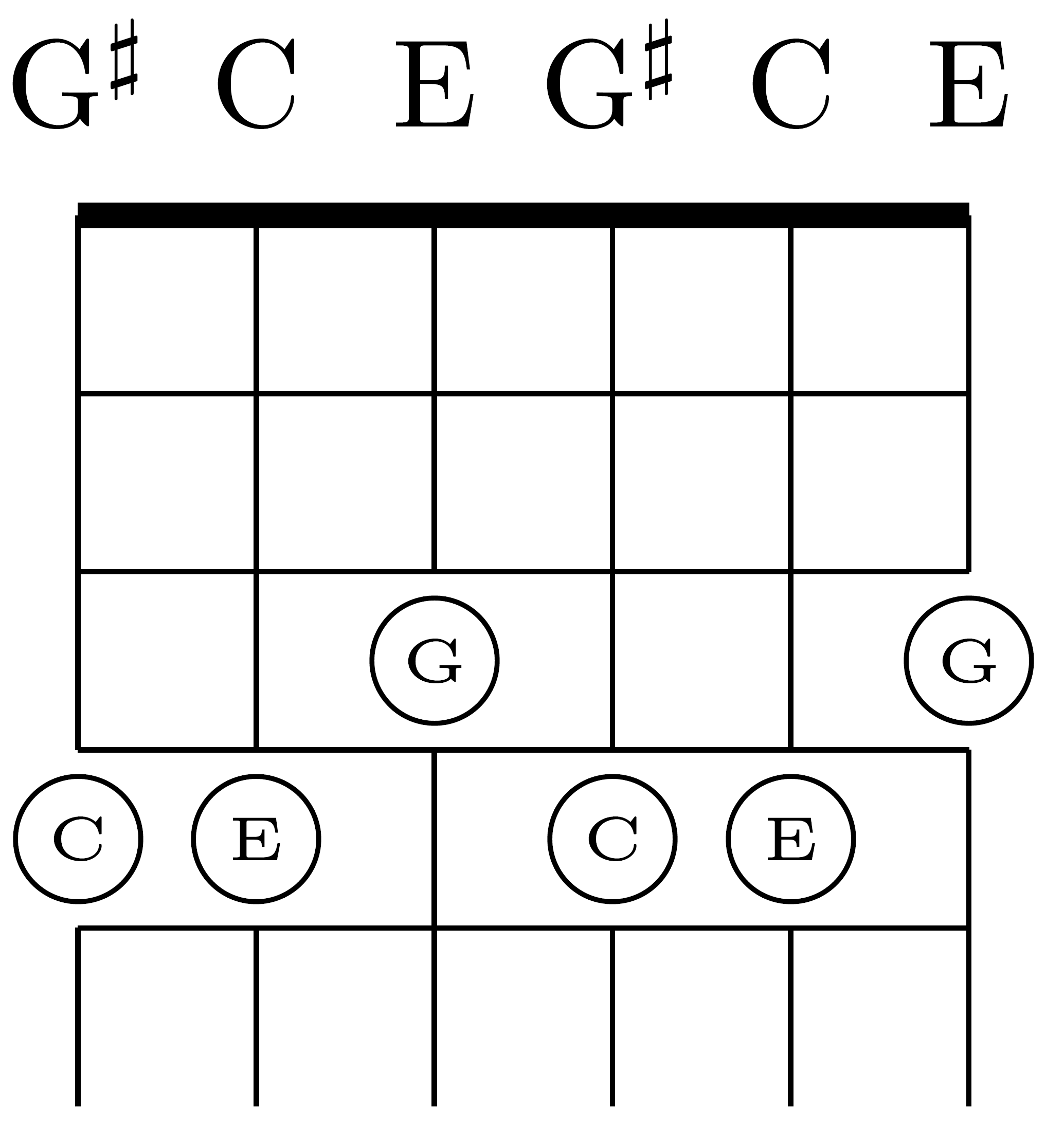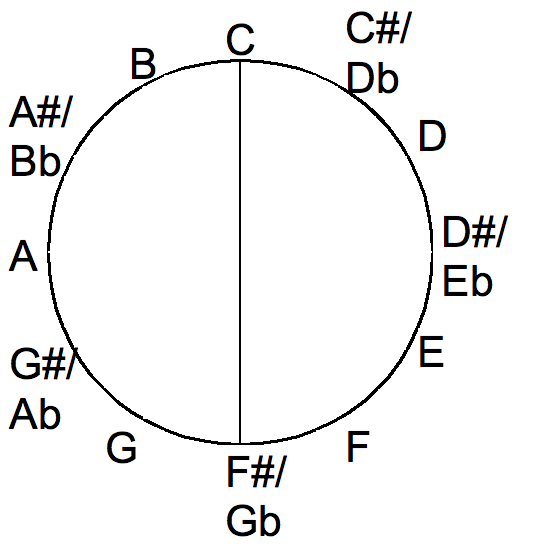Repetitive tuning on:
[Wikipedia]
[Google]
[Amazon]

 Repetitive tunings are a type of alternative tunings for the
Repetitive tunings are a type of alternative tunings for the
 The trivial tuning repeats the same note every string. It is also called a
The trivial tuning repeats the same note every string. It is also called a
 The following tunings repeat their notes after three strings:
*
The following tunings repeat their notes after three strings:
*
 In each minor-thirds tuning, every interval between successive strings is a
In each minor-thirds tuning, every interval between successive strings is a

 Repetitive tunings are a type of alternative tunings for the
Repetitive tunings are a type of alternative tunings for the guitar
The guitar is a stringed musical instrument that is usually fretted (with Fretless guitar, some exceptions) and typically has six or Twelve-string guitar, twelve strings. It is usually held flat against the player's body and played by strumming ...
. A repetitive tuning begins with a list of notes that is duplicated, either at unison or at higher octave
In music, an octave (: eighth) or perfect octave (sometimes called the diapason) is an interval between two notes, one having twice the frequency of vibration of the other. The octave relationship is a natural phenomenon that has been referr ...
s.
Among regular tunings, there are four repetitive-tunings (besides trivially repetitive tunings such as C-C-C-C-C-C); this article discusses three minor-thirds tuning, major-thirds tuning
Among guitar tunings#Alternative, alternative tunings for guitar, a major-thirds tuning is a regular tunings, regular tuning in which each interval (music), interval between successive open string (music), open strings is a major third ("M3" in m ...
, and augmented-fourths tuning
Among guitar tunings#Alternative, alternative guitar tunings, tunings for guitar, each augmented-fourths tuning is a regular tuning in which the musical intervals between successive open string (music), open-string open note, notes are each ...
(but not major second
In Western music theory, a major second (sometimes also called whole tone or a whole step) is a second spanning two semitones (). A second is a musical interval encompassing two adjacent staff positions (see Interval number for more de ...
s tuning, which is not repetitive on six strings). Among open tunings, there are repetitive versions of open C tuning and open G tuning, which have been associated with the English and Russian guitars, respectively.
Repetition eases the learning of fretboard and chords and eases improvisation
Improvisation, often shortened to improv, is the activity of making or doing something not planned beforehand, using whatever can be found. The origin of the word itself is in the Latin "improvisus", which literally means un-foreseen. Improvis ...
. For example, in major-thirds tuning, chords are raised an octave by shifting fingers by three strings on the same frets.
Repetitive tunings are listed after their number of open
Open or OPEN may refer to:
Music
* Open (band), Australian pop/rock band
* The Open (band), English indie rock band
* ''Open'' (Blues Image album), 1969
* ''Open'' (Gerd Dudek, Buschi Niebergall, and Edward Vesala album), 1979
* ''Open'' (Go ...
pitches. For example, the repetitive open-C tuning C-E-G-C-E-G has three open-pitches, each of which is associated with repeated notes .
One
 The trivial tuning repeats the same note every string. It is also called a
The trivial tuning repeats the same note every string. It is also called a unison
Unison (stylised as UNISON) is a Great Britain, British trade union. Along with Unite the Union, Unite, Unison is one of the two largest trade unions in the United Kingdom, with over 1.2 million members who work predominantly in public servic ...
regular tuning
Among guitar tunings#Alternative, alternative guitar tunings, guitar-tunings, regular tunings have equal interval (music), musical intervals between the paired note (music), notes of their successive open string (music), open strings.
...
.
:C-C-C-C-C-C.:
Other trivial-tunings repeat their single notes on a higher octave (or on higher octaves), for example,
:C-C-c-c-c'-c'.
Two
The following tunings repeat their notes on a higher octave after two strings: *Augmented-fourths tuning
Among guitar tunings#Alternative, alternative guitar tunings, tunings for guitar, each augmented-fourths tuning is a regular tuning in which the musical intervals between successive open string (music), open-string open note, notes are each ...
, for example, B-F-b-f-b'-f'.
Any note fingered on one string can be fingered on two other strings. Thus chords can be fingered in many ways in augmented-fourths tuning. It is also a regular tuning in which the interval between its strings is a tritone
In music theory, the tritone is defined as a interval (music), musical interval spanning three adjacent Major second, whole tones (six semitones). For instance, the interval from F up to the B above it (in short, F–B) is a tritone as it can be ...
(augmented fourth).
* A cittern
The cittern or cithren ( Fr. ''cistre'', It. ''cetra'', Ger. ''Cister,'' Sp. ''cistro, cedra, cítola'') is a stringed instrument dating from the Renaissance. Modern scholars debate its exact history, but it is generally accepted that it is d ...
tuning, such as C-G-c-g-c'-g'.
There are other tunings for the cittern.
* Alternating fourths and fifths tuning, such as A1-D2-A2-D3-A3-D4. (ADADAD)
This kind of tuning can also be called modal D or open D5 as it contains a D chord without a third. It is also used on other instruments, e.g. fiddle, mandolin and the Irish bouzouki.
Three
 The following tunings repeat their notes after three strings:
*
The following tunings repeat their notes after three strings:
* Major-thirds tuning
Among guitar tunings#Alternative, alternative tunings for guitar, a major-thirds tuning is a regular tunings, regular tuning in which each interval (music), interval between successive open string (music), open strings is a major third ("M3" in m ...
, such as E-G-c-e-g-c' and
: D-G-B-D-G-B-D,
Chord inversion
In music theory, an inversion is a rearrangement of the top-to-bottom elements in an interval, a chord, a melody, or a group of contrapuntal lines of music. In each of these cases, "inversion" has a distinct but related meaning. The concept of i ...
is especially simple in major-thirds tuning. Chords are inverted simply by raising one or two notes three strings. The raised notes are played with the same finger as the original notes. The major-thirds tuning is also a regular tuning having a major third
In music theory, a third is a Interval (music), musical interval encompassing three staff positions (see Interval (music)#Number, Interval number for more details), and the major third () is a third spanning four Semitone, half steps or two ...
interval between strings.
* Open G tuning, which is used as D', G', B, D, g, b, d' for the (7-string) Russian guitar.
* Open C tuning.: For the English guitar's open C tuning, there are ten strings—of which the highest eight are paired in four courses (duplicated strings), C E GG cc ee gg.
Four
 In each minor-thirds tuning, every interval between successive strings is a
In each minor-thirds tuning, every interval between successive strings is a minor third
In music theory, a minor third is a interval (music), musical interval that encompasses three half steps, or semitones. Staff notation represents the minor third as encompassing three staff positions (see: interval (music)#Number, interval numb ...
. It repeats its open-notes after four strings. Doubled notes have different sounds because of differing "string widths, tensions and
tunings, and heyreinforce each other,
like the doubled strings of a twelve string guitar
add chorusing and depth," according to William Sethares.
In the minor-thirds tuning beginning with C,
: C-D-F-a-c-d
the open strings contain the notes (c, d, f) of the diminished C chord. The minor-thirds tuning is also a regular tuning, which has a minor third
In music theory, a minor third is a interval (music), musical interval that encompasses three half steps, or semitones. Staff notation represents the minor third as encompassing three staff positions (see: interval (music)#Number, interval numb ...
interval between consecutive strings.
See also
*Scordatura
Scordatura (; literally, Italian for "discord", or "mistuning") is a Musical tuning, tuning of a string instrument that is different from the normal, standard tuning. It typically attempts to allow special effects or unusual Chord (music), chords ...
, alternative tunings of stringed instruments
* Stringed instrument tunings
Notes
References
* * {{Guitar tunings, Repetitive Repetitive guitar-tunings